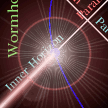Penrose diagrams
Definition of a Penrose diagram
A Penrose diagram is a kind of spacetime diagram
arranged to make clear the complete causal structure of any given geometry.
They are an indispensable map for navigating inside a black hole.
Roger Penrose,
who invented this kind of diagram in the early 1950s,
himself calls them conformal diagrams.
In a Penrose diagram:
- Light rays move at 45o from the upward vertical;
- Points at infinity (at infinite distance, or in the infinite past or future) are contained in the diagram.
|
A detailed exposition, complete with animated spacetime diagrams,
on how the Penrose diagram of the Schwarzschild geometry is constructed
can be found at
More about the Schwarzschild Geometry
on the
Falling into a Black Hole website.
Penrose diagram of a Schwarzschild black hole
The movie of the journey into a
black hole showed that the horizon appeared to split into two when you fell through it.
The Penrose diagram of the Schwarzschild geometry
clarifies this unexpected behavior.
The Penrose diagram
shows that the horizon is really two distinct entities,
the Horizon, and the Antihorizon.
The Horizon is sometimes called the true horizon.
It's the horizon you actually fall through if you fall into a black hole.
The Antihorizon might reasonably called the illusory horizon.
In a real black hole formed from the collapse of the core of a star,
the illusory horizon is replaced by an exponentially redshifting
image of the collapsing star.
As the collapsing star settles towards its final
no-hair state,
its appearance tends to that of a no-hair black hole.
This
animated gif (12K)
version of the Penrose diagram illustrates light rays
that start from the Antihorizon, or from the Horizon, and hit the observer.
The diagram shows that when you look at a black hole from the outside,
you are looking at its Antihorizon, or illusory horizon.
When you fall through the horizon,
you fall not through the Antihorizon, but rather through the Horizon,
or true horizon.
The Horizon becomes visible only after you have fallen through it.
The Antihorizon continues to remain ahead of you,
and you never fall through it.
Penrose diagram of the complete, analytically extended Schwarzschild geometry
What is beyond the Antihorizon of a black hole?
In a real black hole,
the other side of the Antihorizon, or illusory horizon,
is the star that collapsed, redshifted to blackness.
However,
the Schwarzschild geometry has a simple mathematical form,
and that form can be extended analytically.
The mathematical extension consists of a second copy of the Schwarzschild geometry,
reversed in time, glued along the Antihorizon.
The complete analytic extension of the Schwarzschild geometry
contains not only a Universe and a Black Hole,
but also a Parallel Universe and a White Hole.
This is simply a mathematical construction,
with no basis in reality.
Still, it is cute that
even the simplest kind of black hole,
a Schwarzschild black hole,
harbors alien mathematical passageways.
Penrose diagram of a Reissner-Nordström black hole
The Penrose diagram helps to make sense of the strange experience on your journey into a
black hole.
This
animated gif (90K)
version of the Penrose diagram
illustrates how an infaller sees infinitely bright,
infinitely blueshifted

bursts of light:
- On passing inward through the inner horizon,
the infaller sees the infinite past of the Universe reflected in the gravitationally repulsive singularity;
- On passing back outward through the inner horizon,
the infaller sees the infinite future of the Universe;
- On passing outward through the outer horizon of the white hole,
the infaller sees the infinite past of the New Universe.
|
I've given the various regions and horizons of the Reissner-Nordström spacetime names.
General relativists do not commonly name all the pieces this way,
and they might not agree with my naming choices.
Penrose diagram of an extremal Reissner-Nordström black hole
The inner and outer horizons of a Reissner-Nordström (charged) black hole
occur at radii
r± =
M ± (
M2 −
Q2)
1/2.
Horizons exist only if the black hole's charge
Q
is less than or equal to its mass
M,
in natural units.
The extreme case where the charge equals the mass
is called an extremal black hole.
For an extremal black hole, the inner and outer horizons coincide.
As illustrated by its Penrose diagram,
the topology of an extremal Reissner-Nordström black hole
differs from the standard Reissner-Nordström topology.
For this reason and others,
it is thought that an extremal Reissner-Nordström black hole
cannot be constructed, even in principle, by adding charge
to a standard Reissner-Nordström black hole.
Indeed,
adding charge to a near-extremal black hole takes energy,
which increases the mass of the black hole, keeping it sub-extremal.
The mathematical solutions for super-extremal Reissner-Nordström black holes,
those with charge exceeding mass,
have no horizons at all,
which is an even more drastic change in topology.
Real charged particles such as electrons and protons
have charge greatly exceeding their mass.
For example, an electron has a charge-to-mass of
e/me ≈ 10
21
(the ratio of the square root of the fine structure constant
to the electron mass in Planck units).
However,
the character of such particles is dominated by quantum mechanics,
not by classical general relativity.
Penrose diagram of a Kerr black hole
The Penrose diagram of the Kerr geometry for a rotating black hole
looks like the Penrose diagram of the Reissner-Nordström geometry for a charged black hole,
except that it is possible to pass through the disk bounded by the ring singularity
of the rotating black hole to an antiverse.
References
-
Roger Penrose (1964)
“Conformal treatment of infinity”
in Relativity, groups and topology
ed. C. de Witt & B. de Witt
(Gordon and Breach, New York)
p. 563-584;
republished (2011) Gen. Rel. Grav. 43 901-922
10.1007/s10714-010-1110-5
 bursts of light:
bursts of light: